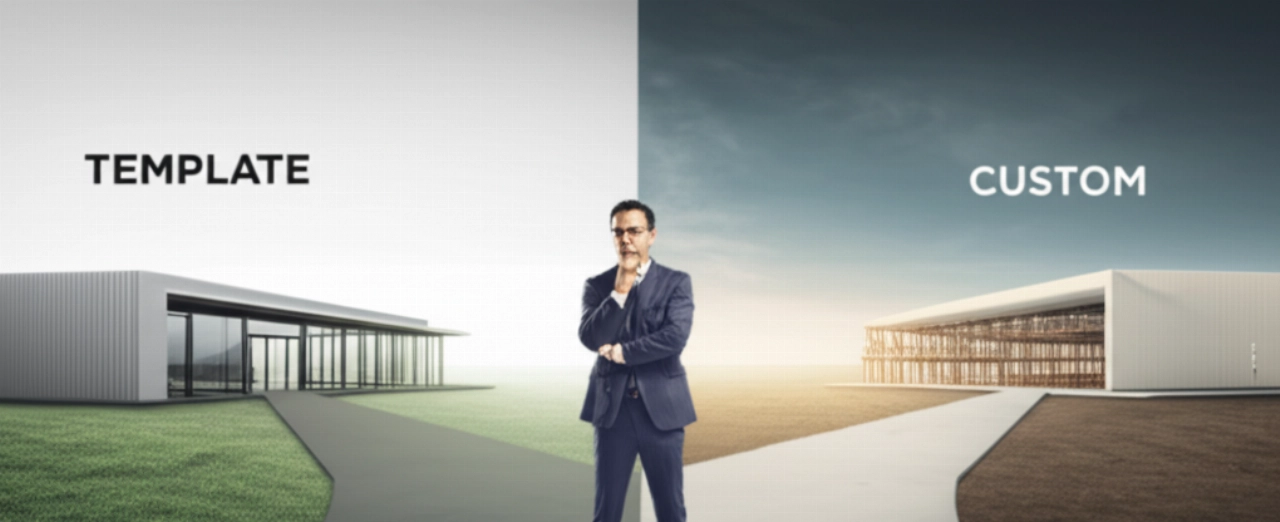The decision looms large for every enterprise leader: Do we opt for the perceived simplicity and lower upfront template vs custom ecommerce cost? Or do we invest in a bespoke solution tailored precisely to our unique business DNA?
For CTOs, E-commerce VPs, and CEOs, this isn't merely a budgetary line item. It's a strategic crossroads that dictates your company's future scalability, operational efficiency, and competitive agility. Choose wisely, and you engineer a powerful growth engine. Choose poorly, and you risk hitting a scalability ceiling, drowning in integration hell, or enduring the terror of a failed migration that cripples your digital presence.
At Commerce-K.com, we understand this dilemma isn't about saving a few dollars today. It's about preventing millions in technical debt and lost opportunities tomorrow. This article will cut through the noise, providing the clarity and strategic framework you need to make an informed decision that drives unparalleled ROI and future-proofs your digital commerce.

The 'Off-the-Shelf' Trap: Why Template Ecommerce Can Strangle Enterprise Growth
On the surface, template-based ecommerce platforms (like basic Shopify plans or even highly customized WooCommerce setups) promise rapid deployment and a seemingly lower template vs custom ecommerce cost. But for mid-market to enterprise-level businesses, this often proves to be a mirage, leading to the dreaded 'one-size-fits-all' trap.
- The Scalability Ceiling: Your business is growing. Your traffic spikes during peak seasons. Can your template platform handle it without buckling? Often, the answer is no. Basic templates are not built for the complex demands of high-volume transactions, extensive product catalogs, or intricate B2B pricing structures. They quickly become a bottleneck, killing conversions and frustrating customers.
- Integration Hell: Your ERP, PIM, CRM, and WMS systems are the lifeblood of your operations. A template platform, by its very nature, offers limited flexibility for deep, seamless integrations. This leads to manual data entry, disconnected workflows, and a chaotic operational nightmare that drains resources and introduces errors. The 'cost' of these inefficiencies far outweighs any initial savings.
- Lack of Competitive Differentiation: In a crowded digital landscape, your ecommerce platform should be a strategic asset, not a generic storefront. Templates force you into predefined layouts and functionalities, making it nearly impossible to implement unique B2B workflows, complex product configurators, or bespoke customer experiences that set you apart. You end up looking and functioning just like your competitors.
- Performance Bottlenecks: A slow site kills conversions. Templates, often laden with unnecessary code or lacking optimized infrastructure, frequently suffer from poor loading speeds. This anxiety-inducing performance directly impacts your bottom line, especially during critical sales periods.
The true cost of a template solution isn't just its license fee; it's the hidden expenses of workarounds, manual processes, lost sales due to poor performance, and the eventual, inevitable need for a costly replatforming project.

Beyond the Price Tag: How Custom Ecommerce Becomes Your Strategic Growth Engine
When evaluating template vs custom ecommerce cost, enterprise leaders must shift their perspective from 'expense' to 'strategic investment'. A custom ecommerce solution isn't just a website; it's a meticulously engineered digital commerce engine designed to meet your precise business needs and future ambitions.
- Unparalleled Scalability & Performance: Custom solutions are built from the ground up to handle your current and projected traffic, product complexity, and transaction volumes. This means no more worrying about your site crashing during a flash sale or slowing down under the weight of your growing catalog. We engineer for peak performance and limitless growth.
- Seamless Integration & Operational Harmony: This is where custom truly shines. We design your platform to integrate flawlessly with your existing ERP, PIM, CRM, WMS, and other critical business systems. This eliminates data silos, automates workflows, and provides a single source of truth, transforming your operational nightmare into a streamlined, efficient ecosystem. This deep integration strategy is key to reducing your Total Cost of Ownership (TCO) over time.
- Competitive Moat & Unique Customer Experiences: Imagine a platform that perfectly supports your complex B2B pricing models, intricate product configurations, or unique customer portals. A custom build allows you to implement proprietary features and workflows that your competitors cannot easily replicate, creating a distinct competitive advantage. This is about building a platform that truly reflects your brand and serves your customers in a way no off-the-shelf solution ever could.
- Future-Proofing with Composable Commerce: We don't just build for today; we build for tomorrow. Our custom solutions often leverage composable commerce principles and MACH architecture (Microservices, API-first, Cloud-native, Headless). This modular approach ensures your platform is flexible, adaptable, and can evolve with emerging technologies and changing market demands, eliminating the need for costly, disruptive replatforming every few years.
The initial investment in a custom solution delivers exponential ROI by optimizing operations, enhancing customer experience, and providing a foundation for sustained, profitable growth.

The Strategic Investment Framework: Evaluating Template vs. Custom Ecommerce Cost for Long-Term ROI
Making the right choice between a template and custom solution requires a comprehensive strategic framework. It's not about the initial sticker price, but about the long-term value and avoidance of future pitfalls.
- Assess Your Unique Business Logic & B2B Workflows: Do you have complex pricing tiers, custom approval processes, intricate product configurators, or specific B2B purchasing workflows? If your business operates beyond standard retail models, a template will likely require extensive, costly customizations or simply won't suffice.
- Evaluate Scalability Requirements: What are your projected growth rates for traffic, product catalog size, and order volume over the next 3-5 years? Will your current or a template platform genuinely scale without performance degradation or prohibitive upgrade costs?
- Map Your Integration Needs: List every critical system (ERP, PIM, CRM, WMS, marketing automation) that needs seamless, real-time integration. Assess the complexity of these integrations. Templates often provide superficial integrations, leading to data silos and manual work.
- Calculate Total Cost of Ownership (TCO): Look beyond the license fee. Factor in customization costs, integration complexities, ongoing maintenance, potential performance issues, lost revenue from downtime, and the cost of manual workarounds. A custom solution, while having a higher upfront cost, often delivers a significantly lower TCO over its lifespan due to efficiency gains and reduced operational overhead.
- Consider Your Competitive Landscape: What unique digital experiences or functionalities could give you a decisive edge? If your competitors are leveraging highly tailored platforms, a generic template will leave you behind.
- Future-Proofing & Flexibility: How important is it for your platform to adapt quickly to new technologies, market shifts, or business model changes? Custom, composable architectures offer unparalleled agility.
This framework ensures you're making a decision based on strategic foresight, not just immediate cost, ultimately leading to a higher ROI.
Case Study: From Integration Hell to Seamless Operations – A Custom Success Story
A leading European B2B distributor, generating €75M annually, was trapped in an integration hell. Their existing template-based ecommerce platform was a silo, disconnected from their legacy ERP, PIM, and CRM systems. Orders required manual processing, product data was inconsistent, and customer service lacked a unified view. The result: escalating operational costs, frustrated customers, and a significant performance bottleneck during peak periods.
Commerce K engaged with their CTO and E-commerce VP to understand their intricate B2B workflows and long-term vision. We proposed a custom, headless ecommerce solution built on a robust framework, designed for deep, real-time integrations.
Our team engineered bespoke APIs to connect their new commerce engine seamlessly with their existing ERP for inventory and order management, their PIM for enriched product data, and their CRM for a 360-degree customer view. We also implemented custom pricing rules and a self-service portal tailored to their B2B buyers.
The outcome was transformative:
- Operational Efficiency: Manual order processing was virtually eliminated, reducing operational costs by 30%.
- Performance Boost: Site speed improved by 45%, leading to a 15% increase in conversion rates.
- Scalability Unlocked: The new architecture effortlessly handled a 200% increase in traffic during their busiest quarter, proving its future-readiness.
- Reduced TCO: While the upfront investment was higher than a template, the long-term savings from reduced manual labor, improved data accuracy, and enhanced customer satisfaction resulted in a projected Total Cost of Ownership reduction of 25% over five years.
This wasn't just a replatforming; it was a strategic overhaul that turned their digital commerce into a competitive advantage.
Beyond the Build: Partnering with Commerce K for Unrivaled Digital Commerce Excellence
The choice between template vs custom ecommerce cost is complex, but the path to success is clear: partnership. At Commerce K, we don't just execute; we strategize, design, and engineer. We are not merely a vendor; we are an extension of your team, committed to de-risking your multi-million dollar investment and ensuring your digital commerce initiative delivers measurable, transformative results.
Our expertise spans the entire spectrum of enterprise ecommerce, from intricate B2B workflows and complex ERP integration to cutting-edge composable commerce architectures. We bring the E-E-A-T (Experience, Expertise, Authoritativeness, Trustworthiness) that only comes from successfully navigating the most challenging digital transformations for global leaders.
We understand the fear of a failed migration, the frustration of the 'one-size-fits-all' trap, and the anxiety of a performance bottleneck. Our approach is built on transparency, meticulous planning, and a relentless focus on your long-term ROI and competitive advantage.
Frequently Asked Questions about Template vs Custom Ecommerce Cost
What is the true ROI of a custom ecommerce solution compared to a template?
While a custom solution has a higher upfront cost, its ROI is typically far greater over the long term. This is due to enhanced operational efficiency (through deep integrations and automation), superior scalability, improved conversion rates from optimized user experiences, and the ability to implement unique competitive features. The reduced Total Cost of Ownership (TCO) from avoiding costly workarounds and future replatforming often makes custom the more financially sound choice for enterprises.
How does a custom build impact SEO during migration or launch?
A well-executed custom build, especially one involving a migration, prioritizes SEO continuity. At Commerce K, our process includes meticulous SEO audits, comprehensive redirect strategies, content mapping, and technical SEO optimization from day one. Our goal is not just to maintain but to enhance your organic visibility, ensuring zero loss of rankings and often significant gains post-launch. This mitigates the common fear of a failed migration impacting SEO.
What are the typical timelines for a custom enterprise ecommerce project?
Timelines for custom enterprise projects vary significantly based on complexity, integration requirements, and the scope of unique features. Generally, a comprehensive custom solution for a mid-market to enterprise client can range from 9 to 18 months. Our agile methodology ensures transparent progress, continuous feedback, and phased rollouts to deliver value incrementally and efficiently.
Can a custom solution integrate with our existing legacy systems (ERP, CRM, WMS)?
Absolutely. One of the primary advantages of a custom ecommerce solution is its ability to achieve deep, seamless, and real-time integration with your existing legacy systems. We specialize in complex ERP integration, PIM, CRM, and WMS connectivity, building robust APIs and data synchronization strategies that eliminate data silos and automate critical business processes, resolving the pain of integration hell.
Is a custom solution always more expensive than a highly customized template?
Not necessarily in the long run. While the initial investment for a custom build is typically higher, the cost of heavily customizing a template to meet complex enterprise needs can quickly escalate, often exceeding the cost of a bespoke solution. Furthermore, these template customizations are often fragile, difficult to maintain, and limit future scalability. When considering the Total Cost of Ownership (TCO), including maintenance, performance, and the cost of missed opportunities, a custom solution frequently proves to be more cost-effective and delivers a far superior ROI.
Stop navigating technical debt. Your business deserves a clear digital commerce roadmap that delivers measurable results. The first step isn't a quote; it's a no-obligation Scoping & Strategy Session with our senior architects. We'll help you map your potential and de-risk your investment. Click here, tell us about your project, and discover the opportunities you're currently missing. Start building your future-proof commerce engine today.
Further Reading:





